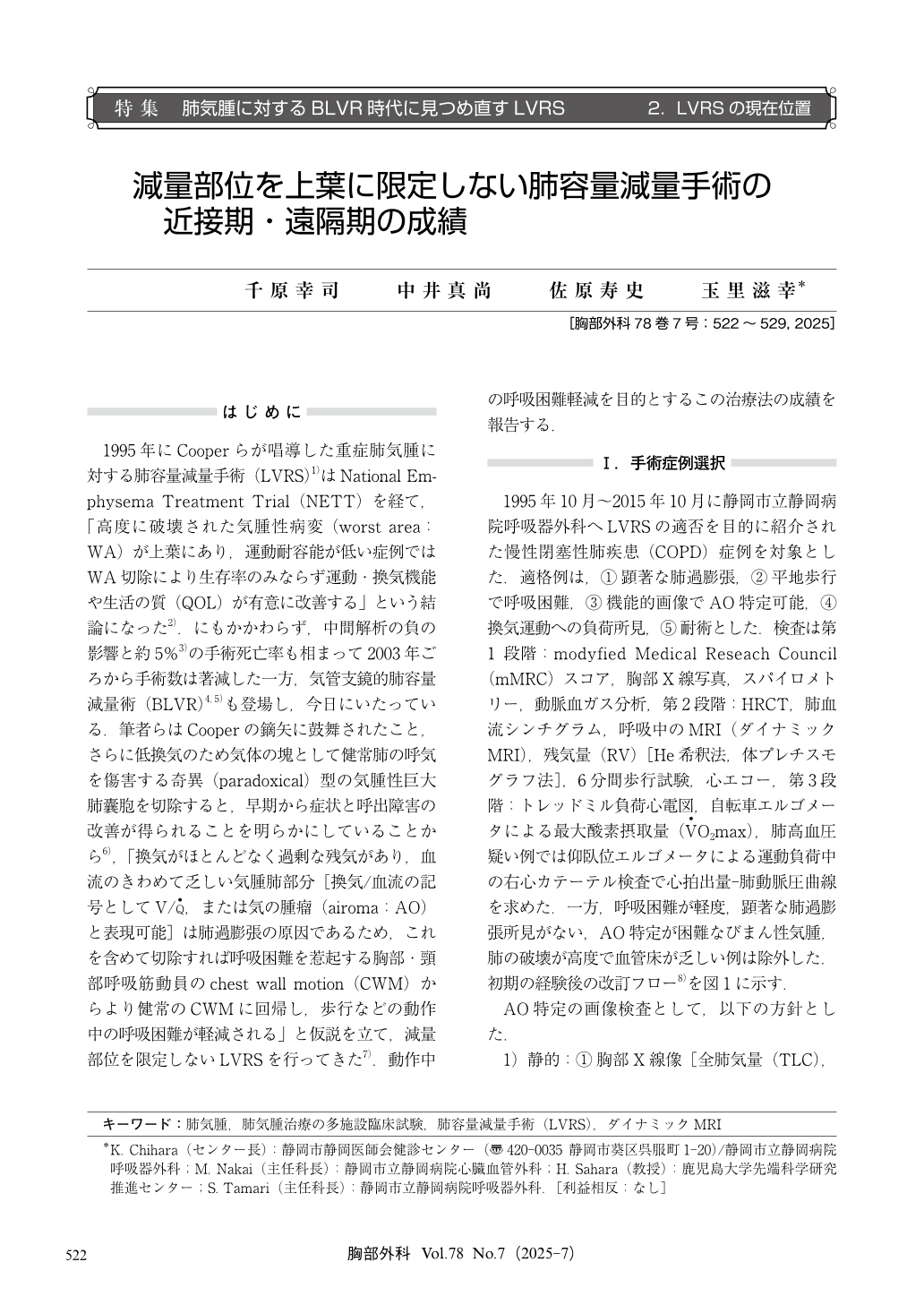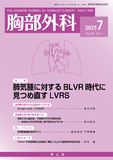Japanese
English
- 有料閲覧
- Abstract 文献概要
- 1ページ目 Look Inside
- 参考文献 Reference
1995年にCooperらが唱導した重症肺気腫に対する肺容量減量手術(LVRS)1)はNational Emphysema Treatment Trial(NETT)を経て,「高度に破壊された気腫性病変(worst area:WA)が上葉にあり,運動耐容能が低い症例ではWA切除により生存率のみならず運動・換気機能や生活の質(QOL)が有意に改善する」という結論になった2).にもかかわらず,中間解析の負の影響と約5%3)の手術死亡率も相まって2003年ごろから手術数は著減した一方,気管支鏡的肺容量減量術(BLVR)4,5)も登場し,今日にいたっている.筆者らはCooperの鏑矢に鼓舞されたこと,さらに低換気のため気体の塊として健常肺の呼気を傷害する奇異(paradoxical)型の気腫性巨大肺囊胞を切除すると,早期から症状と呼出障害の改善が得られることを明らかにしていることから6),「換気がほとんどなく過剰な残気があり,血流のきわめて乏しい気腫肺部分[換気/血流の記号としてV/q,または気の腫瘤(airoma:AO)と表現可能]は肺過膨張の原因であるため,これを含めて切除すれば呼吸困難を惹起する胸部・頸部呼吸筋動員のchest wall motion(CWM)からより健常のCWMに回帰し,歩行などの動作中の呼吸困難が軽減される」と仮説を立て,減量部位を限定しないLVRSを行ってきた7).動作中の呼吸困難軽減を目的とするこの治療法の成績を報告する.
The basic patient selection criteria in lung volume reduction surgery (LVRS) is that the target area (TA) is located in the upper lobe since National Emphysema Treatment Trial (NETT). TA could be described as “airoma” (AO) with excess residual volume and poor perfusion, which compresses the adjacent lung and heart during expiration and causes dyspnea during walking. After Cooper’s landmark report, we defined AO not only by functional static images such as high resolution computed tomography (HRCT) and perfusion scintigrams but also dynamic image of magnetic resonance imaging (MRI) during ventilation, and selected 36 patients with a mean age of 69 years, body mass index (BMI) of 18 kg/m2, modified Medical Research Council (mMRC) of 2.7, PaO2 of 68 mmHg, PaCO2 of 44 mmHg, forced expiratory volume in on second (FEV1)% of 29, % residual volume (RV) of 255, 6-min walk of 285 m, and VO2 max of 12.5 ml/kg/min from October 1995 to October 2015. AO was located in the upper lobe in 19 patients, in the lower lobe in 13 patients, and in the middle lobe or bi-lobes in 4 patients. Reduction of AO was performed by median sternotomy or video-assisted thoracic surgery (VATS). There was zero 90-day operative mortality and zero in-hospital mortality. Thirty-three of 36 patients were satisfied with decrease in dyspnea during walking, and three disappointed. The median follow-up for all patients was 4.5 years. The 1, 3, and 5-year survival rates in the upper lobe group were 100%, 94%, and 49%, respectively, compared with 92%, 77%, and 54%, respectively, in the lower lobe group. There was no difference in survival between the two groups. We believe that selected patients with lower lobe AO are candidates for LVRS, as well as upper lobe AO.

© Nankodo Co., Ltd., 2025


